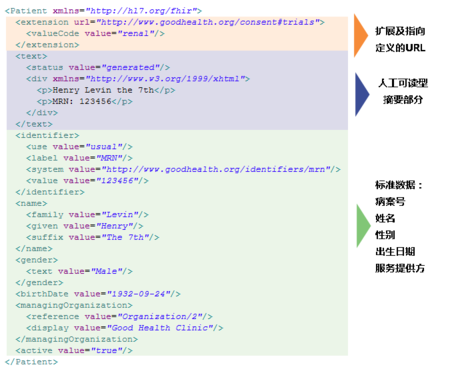Summary - FHIR DSTU 1 (v0.0.82)
目录
[隐藏]1.7 Introducing HL7 FHIR 
FHIR® – Fast Healthcare Interoperability Resources (hl7.org/fhir) – is a next generation standards framework created by HL7. FHIR combines the best features of HL7’s Version 2, Version 3 and CDA® product lines while leveraging the latest web standards and applying a tight focus on implementability.
FHIR solutions are built from a set of modular components called “Resources”. These resources can easily be assembled into working systems that solve real world clinical and administrative problems at a fraction of the price of existing alternatives. FHIR is suitable for use in a wide variety of contexts – mobile phone apps, cloud communications, EHR-based data sharing, server communication in large institutional healthcare providers, and much more.
1.7.1 Why FHIR is better
FHIR offers many improvements over existing standards:
- A strong focus on implementation – fast and easy to implement (multiple developers have had simple interfaces working in a single day)
- Multiple implementation libraries, many examples available to kick-start development
- Specification is free for use with no restrictions
- Interoperability out-of-the-box– base resources can be used as is, but can also be adapted for local requirements
- Evolutionary development path from HL7 Version 2 and CDA – standards can co-exist and leverage each other
- Strong foundation in Web standards– XML, JSON, HTTP, Atom, OAuth, etc.
- Support for RESTful architectures and also seamless exchange of information using messages or documents
- Concise and easily understood specifications
- A Human-readable wire format for ease of use by developers
- Solid ontology-based analysis with a rigorous formal mapping for correctness
1.7.2 Flexibility
A central challenge for healthcare standards is how to handle variability caused by diverse healthcare processes. Over time, more fields and optionality are added to the specification, gradually adding cost and complexity to the resulting implementations. The alternative is relying on custom extensions, but these create many implementation problems too.
FHIR solves this challenge by defining a simple framework for extending and adapting the existing resources. All systems, no matter how they are developed, can easily read these extensions and extension definitions can be retrieved using the same framework as retrieving other resources.
In addition, each resource carries a human-readable text representation using html as a fallback display option for clinical safety. This is particularly important for complex clinical information where many systems take a simple textual/document based approach.
1.7.3 Example Resource: Patient
This simple example shows the important parts of a resource: a local extension, the human readable HTML presentation, and the standard defined data content.
<img src="shot.png">
FHIR has resources for administrative concepts such as patient, provider, organization and device as well as a wide variety of clinical concepts covering problems, medications, diagnostics, care plans, financial concerns and more.
1.7.4 The FHIR development process
FHIR is published as a Draft Standard for Trial Use. During the Trial Use phase, HL7 actively monitors implementations in order to continue to improve the specification, and is able to be responsive to their needs. Due to the many advantages FHIR offers, trial use is already beginning right now.
Following this, HL7 will develop FHIR as a full normative specification, most likely through 2015.
http://www.hl7.org/fhir. Follow us on Twitter using #FHIR
